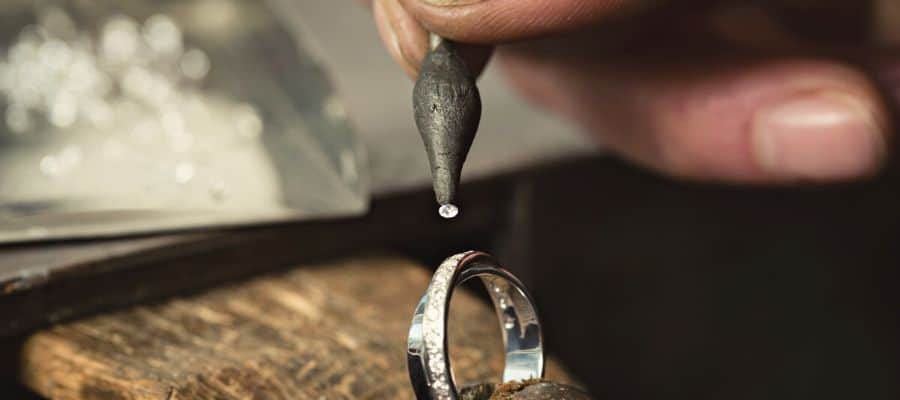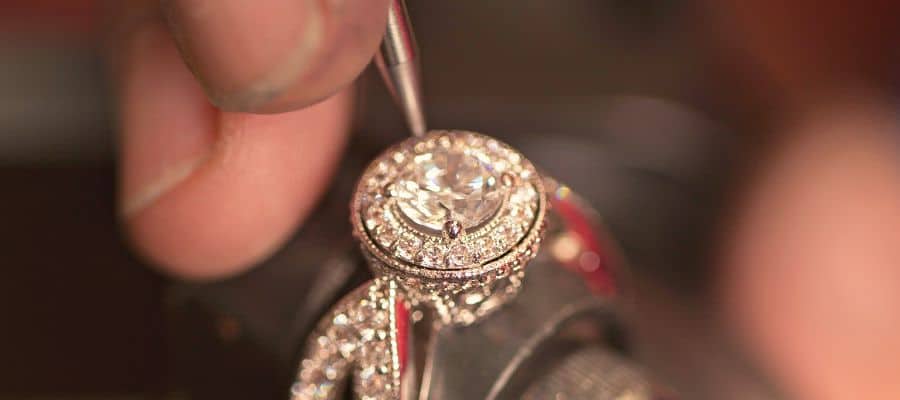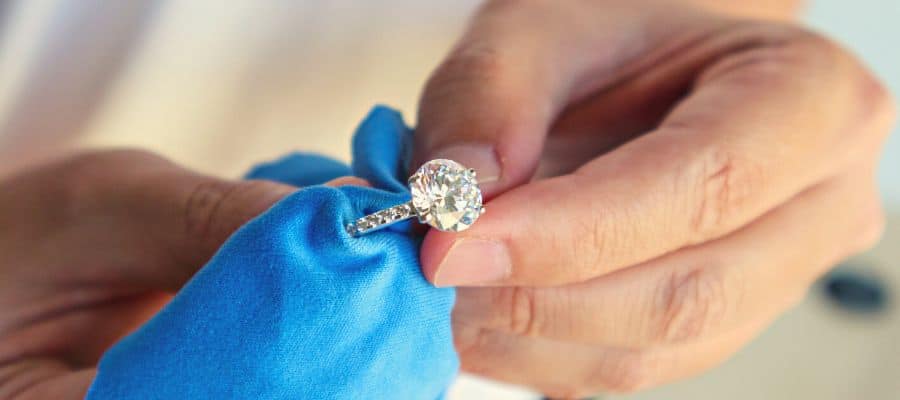Diamond is one of the sturdiest stones humans have known, as proven by its 10 out of 10 ratings on the Mohs scale. They’re not unbreakable, though, with unfortunate chips appearing from time to time. If you’ve had that rare misfortune, you may be wondering whether you can get your broken diamond fixed.
Broken diamonds can’t be fixed, but they can be recut into smaller sizes. However, the cost of recutting a broken diamond isn’t worth it, especially if it’s small or doesn’t hold great sentimental value. Meanwhile, it’s possible to repolish and reset it to repair or hide some damages.
In this post, I will discuss some rectifiable diamond damages along with the options you may have if it can’t be repaired.
What Kind of Diamond Damage Is Fixable?

Diamonds can get damaged in various ways. It can be as simple as the tears of long-term wearing or something more severe like an accidental hit against a sharp object.
Although a broken diamond is impossible to repair, you may still have some options to fix or hide the imperfection of your precious jewel.
However, it will largely depend on the nature of the damage.
1. Tiny Chips or Scratches on the Diamond Surface
Sometimes a diamond can get chipped on such a small scale that it is barely visible to the naked eye. If that’s your case, you may get lucky and fix it with a repolish.
Repolishing a diamond is typical for bringing back the shine of an overused or antique piece. It can also help you from removing a tiny crack or a broken flake by losing only 0.02 to 0.10 ct.
This solution is worth considering as a repolished diamond often looks as gorgeous as new and succeeds in holding most of its value.
2. Cracks Running Under the Girdle of Your Diamond
If your diamond gets chipped underneath the girdle, it may be fixable using one of the prongs holding it. It is more viable for a diamond in a round claw setting.
The jeweler has to rotate the stone in a way that the cracked part sits on the claw. This will hide the damage and keep the appearance intact.
If the damage has removed a portion of the diamond, the claws can be soldered and thickened to fill the hollow space.
However, resetting a diamond may cost between $100 to $500 for the service alone. In addition, any metal required for soldering would incur additional expenses.
3. Cracks Running From the Edges to the Crown
If the cracks under the edges are big enough to run over to the center of the diamond, rotating it over a round claw setting won’t be enough to hide it. In that case, you may have to make do with a setting change.
For instance, Talon claws can be a viable alternative for round claws to hide inclusions in your diamond’s crown. It will be able to mask the cracks atop, as the prongs are extended over to the center of the stone in this setting.
This will also help you somewhat preserve your jewel’s shape and style. In some cases, it may even modernize the look of your jewelry, adding value to its design.
4. Nicks Running Around the Edges of Your Diamond
If you have suffered from a chip that runs around the edges of your diamond, claw settings wouldn’t be that useful to hide it. However, you can still try to hide it by doubling the claws and extending its width. This will also help strengthen the joint and keep the stone safe.
Another option is to let go of the claws and opt for a bezel setting. Running across the entire edge of the diamond, the bezel metal can hide the chips entirely.
You may make do with a full bezel or semi-bezel setting based on the crack size, but unfortunately, this will change your jewel’s original appearance.
5. Minor Chips on a Large Piece of Diamond
If you have a big enough diamond and a visible crack that can’t be polished away, you can ask your jeweler to recut it and remove the damaged section. This will make the stone smaller but bring it up to its faultless appearance.
This solution applies to small to mid-sized diamonds, but you should consider the recutting cost before opting for this solution.
Depending on where you’re located and the quality of your diamond, recutting may cost between $300 – $500. It will also bring down the weight of your diamond, depending on the size of the chip.
Moreover, you may need to recertify and re-insure your diamond. This would add more expenses along with any shipping costs.
A Recut Diamond May Not Fit With Your Existing Design
Recutting will remove a portion of your diamond, so it may not fit into the existing setting of your jewelry item. For example, if you have a 1ct diamond sitting atop a round claw setting and you cut it down to 0.7ct, you will need a resetting.
A viable solution to this can be restyling your jewelry, especially if it doesn’t have much sentimental value. With restyling, you can even opt for a different cut than the original (i.e., oval shape instead of princess cut) and give it a new makeover.
Nevertheless, resetting and restyling will come with their cost, so consider the economics before opting for these solutions.
6. Hole Inclusion and Other Natural Diamond Fractures
Fracture filling is a popular technique to repair different gemstones, including diamonds. It is a process where a glass-like material is applied to fill up natural hole inclusion and other fracture-related imperfections.
This can be an excellent way to fix your damaged diamond if you have lost some flakes in an accidental clash. The filling materials can be applied directly if the crack reaches the surface. Otherwise, laser drilling is utilized to fill up internal gaps.
A fractured filler can help maintain the appearance and transparency of the original diamond. In some cases, it can also improve the clarity of your diamond.
However, the filling can be visible from specific angles under certain lighting conditions. It is also visible under a microscope and can get removed under stress.
While fractured fillers can withstand normal handling, it requires unique manufacturing and repairing techniques.
7. Loss of Clarity in Your Antique or Damaged Diamond
Diamonds attract dirt like a magnet, which makes them lose clarity over time. If dirt is the reason for the clarity loss, you can try to clean them yourself or take them to the experts for ultrasonic cleaning. This will bring the stone back to its sparkling best.
However, these precious gemstones can also lack transparency due to natural imperfections. Fortunately, some natural inclusions like black spots can be repaired by treating them with a powerful laser drilling technique or using fracture fillers. This is how manufacturers make treated diamonds look as good as natural ones.
If you’ve always wanted a colored diamond, you can try to fix the lack of clarity by using irradiation or HPHT (high-pressure, high-temperature) techniques. Diamond manufacturers often use irradiation to create red, yellow, pink, and other colored diamonds, while HPHT can give a diamond a cool black appearance.
The Caveats of Fixing a Damaged Diamond

As you can see, several solutions are available to fix a damaged diamond. However, it does come with a few caveats. Let’s find them out below:
- Repolishing or recutting a heavily shattered diamond may cause further damage to the stone. Some cuts with vulnerable corners, like marquise, princess, and triangular, are prone to be chipped during recutting.
- Hiding a chip under a prong may help to keep up its appearance, but it won’t make its weakness go away. Instead of offering protection, the prong may inadvertently put the stone under heavier stress and cause a larger crack in a future hit.
- Removing a cracked diamond and restyling it with a bezel is complicated and can break your valuable stone further. You must find an expert jeweler who knows what they’re doing for this purpose.
- Using any artificial treatment like fractured filling or HPHT would decrease the value of your diamond by almost 50%. While it would change or improve the appearance, most treatments wouldn’t hold up after repolishing or recutting.
Above all, you should consult a diamond repairing expert to find the best solution. Listen to their advice even if it doesn’t suit your sentiment. It’s also best to take it to the jeweler from where it was bought.
What To Do if a Damaged Diamond Can’t Be Repaired?

All hope isn’t lost if you can’t find a repairing solution for your damaged diamond. You still have a few options to salvage some of its value. So consider all the possibilities before mourning the loss of your precious jewel.
Replace the Damaged Diamond With Insurance
Diamond jewelry is often insured against unintentional losses, thefts, and accidental breaks. If your insurance includes security against chips and cracks, you can replace it with a new diamond.
You can even opt for the same size and cut to preserve its sentimental value without incurring additional costs.
However, claiming insurance coverage for a damaged diamond isn’t as straightforward as thefts or losses. There might be specific clauses attached to it describing which damages are covered (and which aren’t).
So read your diamond’s insurance policy in greater detail to find whether it covers the specific damages in your diamond.
Trade-In Your Broken Diamond for a New One
Diamonds are highly-valuable stones. Whether it got a minor or significant crack, it should still have some value to recover.
You can trade in your damaged diamond for a reduced price with many jewelers. There is no denying that the price you will get for the broken piece would be much lower than what you bought it for, but it’s not entirely negligible.
Besides, you can exchange it for a bigger and better diamond with some jewelry manufacturer. Of course, you would have to pay the difference after deducting the price of the shattered stone, but that may still be a better deal than a cash exchange.
Use the Chipped Diamond in a Different Jewelry
Not all diamond jewelry is similarly injury prone. For example, a ring is more susceptible to accidental damage than a necklace pendant or nose pin.
Therefore, using a chipped diamond in another piece of jewelry can be a viable option if you can’t repair it. In addition to hiding the cracks from plain sight, it can offer better protection for the stone against further cracks and scratches.
However, it will leave a gap in your original jewelry, requiring you to buy a replacement diamond or another gemstone at its own cost.
How To Avoid Damaging a Diamond?

While you cannot avoid accidental damage, you can prevent minor chipping and scratches and maintain the clarity of your diamond by taking good care of it. Proper care and maintenance include:
- Avoiding any metal surface when storing your diamond jewelry. This will save you from minor scratches.
- Cleaning them regularly so that specks of dirt can’t build up. You can use a soft brush and gentle dishwashing liquid to wash them at home.
- Handling your diamond jewelry as sparingly as possible. If you must touch them (i.e., while washing), do it as gently and carefully as you can.
As some diamond cuts are more vulnerable than others, you should choose a sturdy piece with less pointed corners to avoid accidental damage.
Final Words
While a broken diamond can’t be fixed, it shouldn’t be a cause for utter hopelessness. You can repair some minor cracks and nicks by repolishing them or recutting the diamond to a smaller size. Some options like resetting and restyling are also available to hide the damage, albeit with some consequences.
Even if you can’t repair it, you can salvage some of its value by claiming insurance coverage or trading it in for more expensive diamond jewelry. You can also use a chipped diamond in a smaller or different piece of jewelry.


